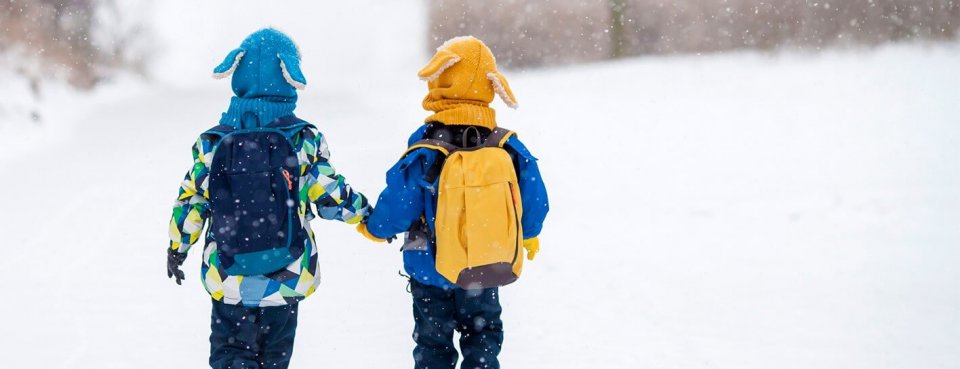We all remember those days as a child when you would wake up on a morning filled with excitement at the sight of snow.
However, snow and ice conditions present a whole host of Health & Safety challenges for school leaders.
To proactively prepare your school for snow and ice, here’s what you should be considering:
Closing your school
In the event of severe snow, you should decide if your school will open as early as you possibly can (making a decision before 7:AM is advisable) and consider how you will let pupils, parents and employees know.
Use a range of communication methods to increase awareness, including sending out text messages and emails, updating your school’s website and social media channels, and informing relevant local media outlets.
When deciding if your school should remain open, points to consider include:
- Where employees and pupils live and the journey they will have to make to and from school;
- If school transport and public transport companies are operating as normal;
- Expected staffing ratios, to ensure pupils are safely supervised;
- Weather forecasts and how conditions are expected to change throughout the day;
- The safety of pedestrian routes on your school’s site;
- If your school has enough maintenance materials, fuel stock,gritting and equipment and stock.
Gritting
You should buy gritting material and suitable equipment well in advance of cold and icy conditions, ensuring that enough supplies are stocked at any one time for at least five days’ use. It’s important that gritting material is stored in a salt or grit bin and everyone knows where to find it. You should also clearly communicate to staff who’s responsible for gritting, and when it will take place, i.e. early morning, and late afternoons.
Areas that are prone to being slippy (e.g. car parks,access roads, pedestrian paths and playgrounds) should be identified, monitored and proactively gritted when necessary.
First aid provisions
Icy conditions increase the risk of slips, trips and falls, reinforcing the importance of ensuring first aid trained employees are always available if needed.
To make sure your school is fully protected (even in the event of absences or employees being unavailable), it might be necessary for some employees to undertake first aid training to increase your school’s first aid provisions.
Heating and water provision
It’s essential that plumbing and heating facilities are working properly during cold periods.
Ongoing questions that you should be asking yourself include:
- Do you have enough fuel stock to appropriately heat your school?
- Are you checking that surface water drains are freely flowing so that areas where water might flood don’t turn into a mini ice rink?
- Is there constant low heating during known cold periods to prevent the freezing of pipes?
- Are caretakers carrying out regular checks of your heating and water systems to ensure that they are working as expected?
- Is there a writtenrecord of previous failures, faults and remedial actions?
Ensure your school’s activities are adaptable
You should be prepared to adapt your school’s daily rules, routines and schedules.
There is no ‘one rule fits all’ when it comes to possible adaptations, but you might consider restricting outdoor play activities, relaxing dress codes to ensure that pupils are warm and comfortable, or making alternative plans for outdoor Physical Education classes.
Use your common sense when making any decisions; snow does not need to grind your school to a halt but should prompt you to take extra care when considering potential Health & Safety hazards and required control measures.
Have a snow and ice policy in place
Your school’s snow and ice policy should be communicated to all employees, clearly identifying everyone’s responsibilities and what procedures should be followed in the event of snow and ice.
This can be also be communicated to parents so that they know what steps you will take to guarantee pupil safety.
Though your policy will be bespoke to your school, general features should include:
- The aims and objectives of your policy, including your commitment to making all reasonable efforts to keep your school open;
- Responsibilities of different individuals, e.g. the headteacher, business/ finance manager,caretaker and premises employees, and all other employees (though sometimes forgotten, contractors should also be considered in this regard);
- Clearance procedures;
- A sitemap, including priority areas for gritting;
- Risk assessments that identify hazards, risks and control measures.
Citation can help
Partnered with education-specialists EPM Ltd, Citation has over 20 years’ experience of keeping schools compliant, so you can be sure you’re in safe hands.
From putting in place Health& Safety policies to getting to grips with accident reporting in education (and everything else in between!), we really do know the sector inside out, and that’s we’ve got over 100 school-specific risk assessment templates available to our clients.
If you’ve got any questions about anything covered in this article, contact the team on 0345 844 1111 or using the contact form on this page.
And remember, if you’re a Citation client, our Health & Safety experts are available 24/7 through our advice line.



